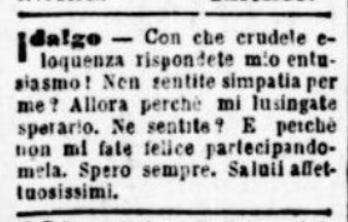While leafing through an Italian local newspaper from the late nineteenth century, in search of period advertisements for a project, I stumbled upon a section of personal ads labeled “MISCELLANEOUS.”
It was June 1899, and a parallel world of coded messages, poetic pseudonyms, and amorous pleas was hidden among the commercial listings.
Intrigued, I decided to go through all the ads published that month to see what emerged.
What I found surprised me: 121 messages forming an involuntary fresco of fin de siècle courtship. Intimacy was transformed into a public spectacle and passion submitted to the rules (and the cost) of typography.
Mysterious recipients like "231," "Amor Bianco," or "Frine" received declarations charged with emotional intensity - often expressed in a D'Annunzian language - but also with frustration and waiting.
With what cruel eloquence you respond to my enthusiasm! Do you feel no sympathy for me? Then why do you flatter me into hoping for it? Do you feel it? And why don't you make me happy by sharing it with me? I always hope. Most affectionate greetings.
someone writes to "Idalgo," in a crescendo of rhetorical questions that reveals how silence was interpreted as a refined form of communication.
The messages follow precise rituals: the art of supplication, the obsessive management of appointment times, the subterfuges to elude society's judging gazes.
Men write to women at a ratio of 7 to 1, transforming the section into a theater of male vulnerability, where insistence becomes virtue and rejection becomes a space for fantasy projection.
The advertising agency managing the ads emerges as the silent arbiter of this communication, censoring overly heated tones and reminding that even love has a price per word.
This corpus opens an unusual window into the mechanisms of bourgeois seduction in the Italian Belle Époque.
Over the next two Sundays, I will explore the most significant stories: Amor Bianco and his exuberant censored passion, G.55 who becomes "Vinto" to avoid inconveniences, the temporal codes of amorous logistics, and the system that turns sentiment into commodity.
A brief archaeology of intimacy, from a time when to love was also to write.
Hope you’ll enjoy it.






I'm intrigued!